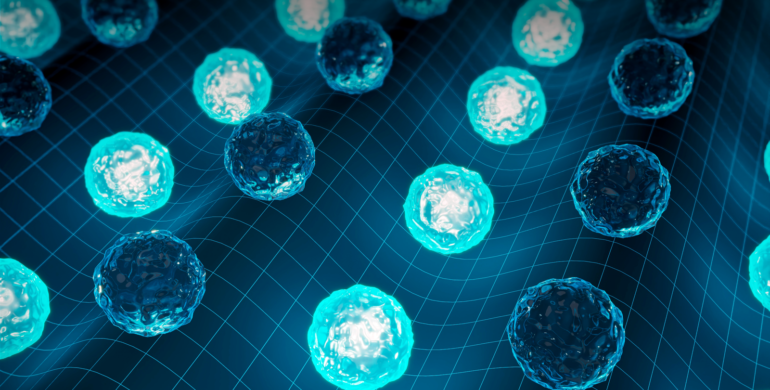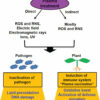Let’s say you needed to move an individual cell from one place to another. How would you do it? Maybe some special tweezers? A really tiny shovel?
The fact is that manipulating individual cells is a difficult task. Some work has been done on so-called optical tweezers that can push cells around with beams of light, but while they are good at moving a single cell around, they are not intended for manipulating larger numbers of cells.
New research conducted at Caltech has created an alternative: air-filled proteins, produced by genetically engineered cells, that can be pushed around—along with the cells containing them—by ultrasound waves. A paper describing the work appears in the journal Science Advances.
The work builds on previous work conducted in the lab of Mikhail Shapiro, professor of chemical engineering and medical engineering and investigator with the Howard Hughes Medical Institute.
Shapiro has for years worked with gas vesicles derived from bacteria as an acoustic tag. These vesicles, which are air-filled capsules of protein, provide buoyancy to some species of aquatic bacteria. But they also have another useful quality: Because of their air-filled interiors, they show up quite strongly in ultrasound imagery. Shapiro’s discovery of this quality has led his lab to develop gas vesicles as a genetic marker for tracking the location of individual bacterial cells, and for observing gene-expression activity in mammalian cells deep inside the body.
Now, Shapiro and his colleagues have shown that these vesicles can push and pull cells into specific locations under the influence of ultrasound. The phenomenon is very similar to how ultrasound in air can be used to suspend and/or move small, light objects. This is due to the fact that sound waves create pressure zones that act on objects in their vicinity. The physical properties of an object or material determine whether it will be attracted to a high-pressure zone or repulsed by it. Normal cells are pushed away from areas of higher pressure, but cells containing gas vesicles are attracted to them.
“We’ve used these vesicles for imaging previously, and this time we’ve shown that we can actually use them as actuators so we can apply force to these objects using ultrasound,” says Di Wu (MS ’16, Ph.D. ’21), a research scientist in Shapiro’s lab and the study’s lead author. “What this allows us to do is to move cells around in space using ultrasound and to be able to do so in a very selective manner.”
Shapiro and Wu say there a few reasons you might want to be able to move cells around. For one, tissue engineering—the creation of artificial tissues for research or medical purposes—requires cells of specific types to be arranged in complex patterns. An artificial muscle might need multiple layers of muscle cells, cells that create tendons, and nerve cells, for example.
Another case in which you might want to move cells around is in cell-based therapy, a field of medicine in which cells with desirable properties are introduced into the body.
“You’re introducing engineered cells into the body, and they go all over the place to find their target,” Di says. “But with this technology, we potentially have a way to guide them to the desired location into the body.”
As a demonstration, the team showed that cells containing gas vesicles can be forced to clump into a small ball, or arranged as thin bands, or pushed to the edges of a container. When they changed the ultrasound pattern, the cells “danced” to take up new positions. They also developed an ultrasound pattern that pushed the cells into the shape of the letter “R” in a gel that held them in that shape after it solidified. They call the resulting figure an “acoustic hologram.”
An ultrasound apparatus arranges gas vesicles into the shape of the letter R in solution. © Lance Hayashida/Caltech
Wu says one area where their research has the potential for immediate impact is in cell sorting, a process necessary for various kinds of biological and medical research.
“A common way people sort cells now is to engineer them to express a fluorescent protein and then use a fluorescent-activated cell sorter (FACS),” he says. “That is a $300,000 piece of equipment that is bulky, often lives in a biosafety cabinet, and doesn’t sort cells very fast.”
“In contrast, acousto-fluidic sorting can be done with a tiny little chip that costs maybe $10. The reason for this difference is that in fluorescent sorting, you have to separately measure the gene expression of the cells and then move them. This is done one cell at a time. With gas vesicle expression, the cell’s genetics are directly linked to the force that’s being applied to the cell. If they express gas vesicles, they will experience a different force, so we don’t need to separately check if they’re expressing gas vesicles and then move them; we can move them all at once. That greatly simplifies things.”
The paper describing the research, titled “Biomolecular actuators for genetically selective acoustic manipulation of cells,” appears in the February 22 of Science Advances.
More information:
Di Wu et al, Biomolecular actuators for genetically selective acoustic manipulation of cells, Science Advances (2023). DOI: 10.1126/sciadv.add9186
Provided by
California Institute of Technology
Citation:
Making engineered cells dance to ultrasound (2023, February 24)



